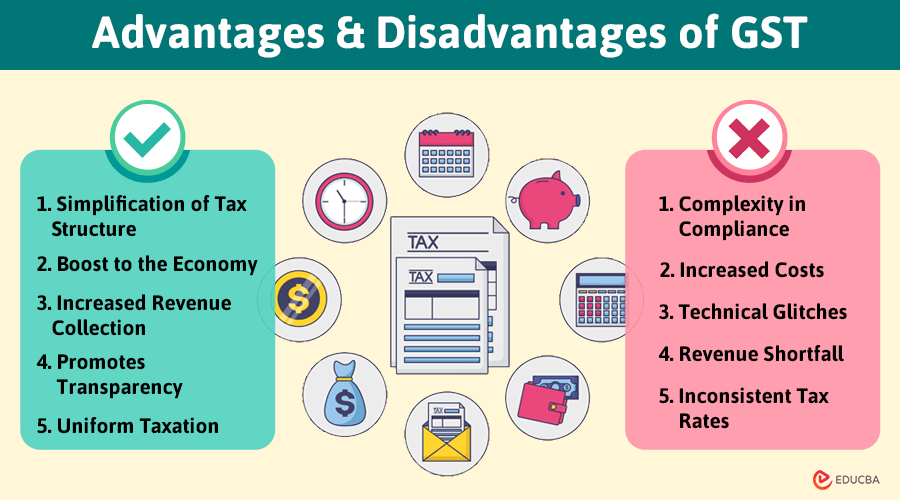Goods and Services Tax (GST)
GST is an indirect tax imposed in India on the sale of goods and services. Introduced on July 1, 2017, and replaced multiple taxes imposed by the central and state governments. GST is a destination-based tax, which means the tax collated on the consumption of products or services. The end consumer pays GST, but registered dealers at each stage of the supply chain can claim it as an input tax credit. The GST council, consisting of the Union and state finance ministers, makes decisions on GST rates and policies. GST aims to simplify the tax system, promote transparency, and increase revenue collection for the government. But everything notion has both merits and demerits. Similarly, this article covers the advantages and disadvantages of GST.
Top 5 Advantages of GST
GST (Goods and Services Tax) has been a game-changer for the Indian economy since its introduction in 2017. GST has brought several benefits to the government and businesses, making the tax system more transparent and efficient. Here are the top five advantages of GST.
#1 Simplification of Tax Structure
Before GST, there were multiple indirect taxes levied by the central and state governments, leading to a complex tax structure for businesses to navigate. GST has replaced all of these taxes with a single tax, making it easier for companies to comply with the tax laws and reducing the administrative burden for the government.
#2 Boost to the Economy
GST has created a seamless national market for goods and services, eliminating the barriers to trade created by the various state taxes. This has resulted in increased competition, reduced transaction costs, and increased efficiency, boosting economic growth and development.
#3 Increased Revenue Collection
GST has reduced the scope for tax evasion and the cascading effect of taxes, leading to increased revenue collection for the government. The online GST filing platform has also made tracking and monitoring tax compliance more accessible, leading to improved compliance and higher revenue collection.
#4 Promotes Transparency
The online platform for GST filing has made the tax system more transparent. Since all the transactions and tax payments can be easily tracked and monitored, it has reduced the scope for corruption and increased accountability in the tax system.
#5 Uniform Taxation
GST ensures that all goods and services become taxed uniformly across the country, reducing the tax rate disparity between states. This uniformity in taxation has encouraged businesses to expand their operations beyond their home state. It has led to increased competition and economic growth.
Top 5 Disadvantages of GST
As stated earlier, GST has various advantages and disadvantages for businesses and the economy. Here are the top five disadvantages of GST.
#1 Complexity in Compliance
GST has introduced a complex tax system with multiple taxation slabs, forms, and compliance requirements. This complexity has made it difficult for businesses, especially small and medium enterprises (SMEs), to comply with the tax laws, leading to increased administrative costs and reduced competitiveness.
#2 Increased Costs
The compliance costs for businesses, including software costs, tax consultant fees, and training costs, have increased under GST. This has burdened companies, especially SMEs, and reduced market competitiveness.
#3 Technical Glitches
The GSTN (Goods and Services Tax Network) online platform for GST filing has faced several technical glitches, leading to inconvenience and delays for businesses. This has made it difficult for companies to file their taxes on time, leading to penalties and interest charges.
#4 Revenue Shortfall
Despite its aim to increase revenue collection, GST has sometimes resulted in a revenue shortfall for the government. This has impacted the government’s ability to carry out public welfare schemes and provide essential services, leading to reduced social welfare and a declining standard of living.
#5 Inconsistent Tax Rates
The GST council periodically changes the tax rates for goods and services, leading to inconsistency in the tax system and causing business confusion. This has also resulted in price fluctuations for consumers, making it difficult for them to budget for their expenses. The inconsistency in tax rates has also led to challenges in the supply chain as businesses struggle to adjust to the changes promptly.
Conclusion
In conclusion, GST has both advantages and disadvantages for businesses and the economy. While GST has simplified the tax structure, boosted the economy, increased revenue collection, and promoted transparency. It has also brought challenges such as complexity in compliance, increased costs, technical glitches, revenue shortfall, and inconsistent tax rates. Despite these challenges, GST remains a vital reform that has the potential to transform the indirect tax system in India. It is also essential for businesses to be aware of the challenges and opportunities presented by GST and to take the necessary steps to comply with the tax laws and maximize the benefits of this reform.
Recommended Articles
We hope that this EDUCBA information on “Advantages & Disadvantages of GST” was beneficial to you. You can view EDUCBA’s recommended articles for more information,

